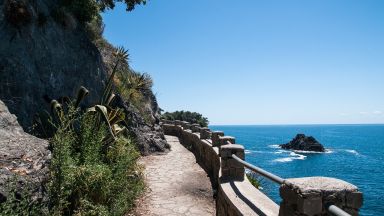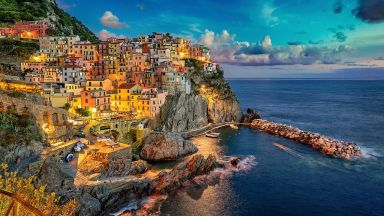Self Guided Walking Tour of Lucca
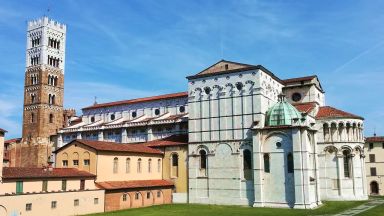
This website uses affiliate links which earn a small commission at no additional cost to you.
Lucca, Italy, is a stunning city in Tuscany with a unique charm. Its well-preserved medieval walls encircle the city, giving it a cozy and untouched feel. Lucca is renowned for its numerous churches, earning it the nickname “the city of a hundred churches.” Additionally, the city’s thriving pottery shops have earned it the title “the city of ceramics.” This combination of history, architecture, and artistic traditions makes Lucca a captivating destination in Italy.
- Thought about touring Lucca by bicycle?
- The City Walls of Lucca
- Lucca Cathedral (Cathedral of San Martino)
- Church of Saint John and Saint Reparata
- Piazza Napoleone
- Museo Puccini
- Church of San Michele in Foro
- Torre delle Ore
- Domus Romana
- Palazzo Pfanner-Controni
- Basilica of San Frediano
- Piazza dell Anfiteatro
- Guinigi Tower (Torre Guinigi)
- Church of St Maria della Rosa
Arriving by Train: This walking tour starts and ends at the Train Station in Lucca.
Arriving by Car: Almost all parking in the immediate periphery is “paid parking” (designated by blue lines) or “permit holders only” (designated by yellow lines). Park outside the city walls / ZTL. Free parking is available to the east of the train station is Parking gratuit.
Parcheggio Piazzale Umberto I is near to the train station and the start of the walk.
Thought about touring Lucca by bicycle?
One of the best ways to explore the city center is by biking. The city is quite compact, meaning you can easily see all the landmarks in a day, especially if you get around faster with a bicycle. There are several guided bike tours available but you can also opt to do a self-guided tour by just renting a bicycle.
The City Walls of Lucca
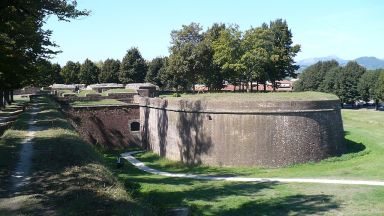
From the train station cross over the small park Piazzale Bettino Ricasoli, carefully crossing the main ring road, at the crossing. Cross the grass to reach the San Colombano Bulwark. Walk anticlockwise around the walls.
Walking along Lucca City Walls is a must-do experience when visiting the city. The entire loop spans just over 4km and offers fantastic views over the rooftops of Lucca. From the walls you can see the medieval defensive towers that still stand within the city, such as the Torre del Ore and Torre Guinigi.
The walls provide convenient on and off-ramps, as well as shady benches for relaxation while walking. Note that weekends, particularly in summer, can get a bit crowded, so early mornings are recommended for a cooler and less crowded experience with the best lighting.
Although not ancient, Lucca City Walls were built in the 16th century as defensive fortifications against rival cities like Genoa, Florence, and Pisa. Standing at 12 meters high and up to 30 meters thick in some places, the walls boast several bastions and town gates to discover during your walk. Don’t miss the opportunity to glimpse into the Botanical Gardens shortly after starting the wall walk and the gardens of the Palazzo Pfanner on the other side!
Tip Tip for Visiting Lucca City Walls: There is a specific guided tour of Lucca’s Renaissance City Walls you can take if you are interested in more specific information.
Read more about Lucca's City Walls
Lucca Cathedral (Cathedral of San Martino)
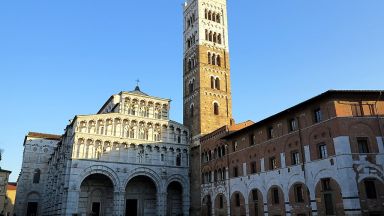
When you arrive back at the San Colombano Bulwark you should be able to see the white building of the Cathedral across the green space. Walking anti-clockwise around it you pass through Piazza Antelminelli and Piazza San Martino until you come to the entrance.
Lucca Cathedral is an absolute must-see when visiting Lucca. Its Romanesque façade is a stunning sight, adorned with delicate arches and intricately carved black and white striped columns. The cathedral was reconstructed in the 13th century, built atop a previous church. The bell tower, which precedes the main cathedral, is made of different materials, giving it a unique appearance.
Upon entering, take note of the sculpture on the right, the famous 13th-century carving of St. Martin, after whom the cathedral is named, along with a beggar. According to the tale, Martin, a soldier, generously cut off part of his cloak to provide warmth to a freezing beggar by the wayside. This act of compassion led to visions of Jesus, his conversion to Christianity, and ultimately his sainthood.
The cathedral’s most precious treasure is the Volto Santo, a carving of Christ on the Cross. Every September, this sacred artefact is carried through the streets of Lucca during a religious procession. Additionally, don’t miss the opportunity to explore the impressive pulpit and admire the exquisite stained glass windows inside the cathedral. These captivating features add to the cathedral’s rich historical and artistic significance, making it a truly awe-inspiring destination in Lucca.
Visiting Lucca Cathedral: Entrance to the main cathedral is €3. Open Mon-Sat 10am-6pm, Sun 12-6pm. There’s a combination ticket for the Cathedral and Church of San Giovanni & Santa Reparata (the next place on our tour). This ticket is €10 and allows you into all the attractions within both churches.
Location: St Martin Cathedral, Piazza Antelminelli, Lucca, Province of Lucca, Italy | Website
Read more about San Martino, Lucca's Cathedral
Church of Saint John and Saint Reparata
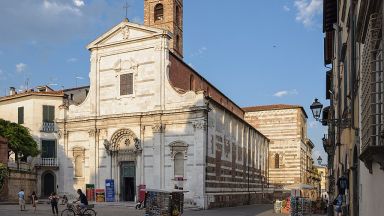
From the Cathedral entrance walk diagonally opposite to the north west and walk down Via Duomo.
The church of Saints Giovanni and Reparata is situated in Piazza San Giovanni, in the Romanesque district of Lucca’s historic center, in close proximity to the Cathedral of San Martino. Throughout history, the church has undergone various transformations and uses. During the Napoleonic period, it served as a storage facility for the archives of the old Republic. In 1828, it was re-consecrated.
Today, the church and baptistery present the result of a reconstruction effort from the twelfth century, blending both elements into the present appearance. Remarkably, visitors have the opportunity to explore the excavations sites that house remnants of the original fifth-century basilica and the early Christian baptistery. These excavations have unearthed a stratification of five levels, corresponding to the five major stages in the history of Lucca, from the Roman period to the late Empire. Below the basilica’s excavations, the remains of the city’s first cathedral can be found.
The building has experienced further changes over time, especially during the High Middle Ages, ultimately leading to its current appearance. Among the fascinating findings in the excavations are a fragment of a first-century BC Roman house pavement, remains of thermal baths dating back to the first-second century BC, Lombard burial sites, and artifacts from the medieval baptistery and Carolingian crypt.
Puccini Festival Opera Recitals and Concerts are held every thur/fri/sat from 1st November until 31st March, in the Church of San Giovanni, book here.
Visiting church of Saints Giovanni and Reparata: It costs €4 to enter the main church, archaeological exhibit and bell tower. Alternatively, see the Combination Ticket. Open 10am-6pm every day.
Location: Church of Saint John and Saint Reparata, Piazza San Giovanni, Lucca, Province of Lucca, Italy | Hours: Monday - Sunday: 10:00 - 18:00 | Price: Church of Santi Giovanni e Reparata Church + Archaeological area + Baptistery + bell tower of San Giovanni Full price: €4.00 | Website
Read more about Church and Baptistery of Santi Giovanni e Reparata
Piazza Napoleone
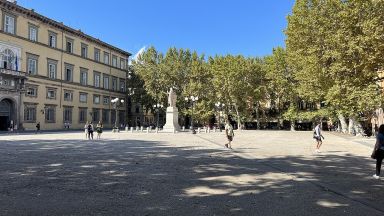
Continue along Via Duomo and you soon come to Piazza del Giglio, in the centre of which is a Statue of Giuseppe Garibaldi. Garibaldi devoted himself to the Italian unification movement and personally led many military campaigns. Italy was unified in Garibaldi 1861. More importantly for the UK the Garibaldi biscuit was invented by Peek Freans in 1861 and was named after the Italian revolutionary of the same name, possibly relating to Garibaldi feeding his Redshirts on raisin sandwiches at some point during the campaign to unify Italy.
Piazza del Giglio connects to the larger Piazza Napoleone.
Piazza Napoleone is a charming and expansive square situated at the heart of Lucca, adorned by numerous impressive buildings. It serves as a vibrant venue for various festivals and events, adding to its lively atmosphere. Along the edges of the square, several inviting cafes offer delightful spots to relax and enjoy the surroundings.
Among the notable buildings facing the square, the Ducale Palace stands out as a prominent attraction. Visitors can pass through its archway, leading to a tranquil courtyard where one can find a sense of serenity amidst the bustling city. Another remarkable edifice is the Giglio Theatre, an architectural gem that adds to the square’s splendour.
Overall, Piazza Napoleone is a captivating destination, combining historical landmarks with a lively ambiance, making it a must-visit location in Lucca for both locals and tourists alike.
Location: Piazza Napoleone, Piazza Napoleone, Lucca, Italy | Hours: 24 Hours | Price: Free
Read more about Piazza Napoleone, Lucca
Museo Puccini
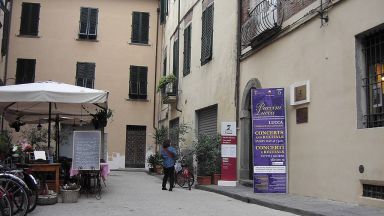
After walking across to the Palazzo Ducale di Lucca walk north along Via Pozzotorelli until you reach Piazza San Michele. Before visiting Chiesa di San Michele in Foro in the square turn left into Via S. Paolino and stop at the Piazza Cittadella to see the Puccini Museum.
The Puccini Museum is dedicated to the life and works of the renowned composer Giacomo Puccini, who was born in Lucca in 1858. The museum showcases the fascinating legacy of this musical genius, famous for creating masterpieces like “La bohème,” “Tosca,” and “Madama Butterfly.” Additionally, visitors can book tickets to attend his operas right at the museum.
Located on the second floor of the house where the composer was born, the museum may be considered somewhat typical and a bit uneventful. However, it provides a glimpse into Puccini’s world through a collection of musical instruments, costumes from his operas, musical scores, and a selection of letters penned by him. Furthermore, the museum offers insights into the social history of Puccini’s time, allowing visitors to appreciate the context in which the composer lived and worked.
Though relatively small, the museum can be explored in about 30 minutes, making it a convenient and enriching stop for those interested in the life and artistic contributions of Giacomo Puccini.
Visiting Puccini Museum: Tickets are €9. The museum is open all year round, but closed on Tuesdays Oct-Mar. It opens at 10am and closes from 2pm to 7pm depending on the season. There’s a free guided tour of the museum in English at noon on Fridays from Jun-Sept.
Location: Puccini Museum Corte S. Lorenzo, 9 55100 Lucca LU Italy | Hours: March Mon – Sun 10:00 am – 6:00 pm Closed on Tuesdays (except on holidays)1st April – 30th September 10:00 am – 7:00 pm Open every day1st October – 1st November Mon – Sun 10:00 am – 6:00 pm Closed on Tuesdays (except on holidays)2nd November – 7th December Mon – Fry 10:00 am – 2:00 pm Sat – Sun 10:00 am – 5:00 pm Closed on Tuesdays (except on holidays and 29th november) and from 7th to 18th November8th December – 8th January 10:00 am – 5:00 pm Closed 25th December9th January – 28th February Mon – Sun 10:00 am – 5:00 pm Closed on Tuesdays (except on holidays)Last admission 30 minutes before closing | Price: Adults € 9,00 | Website
Read more about Puccini Museum in Lucca
Church of San Michele in Foro
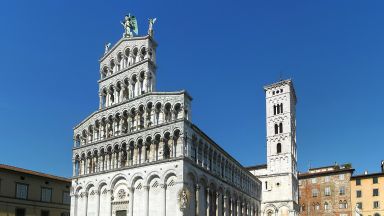
Head back to Piazza San Michele and the Chiesa di San Michele in Foro.
The Church of San Michele, located in the historic center of Lucca, has a history dating back to 1070. It played a significant political role as the meeting place for Lucca’s highest legislative body. The Pisan Romanesque-style facade is adorned with sculptures, including a statue of the Archangel Michael. Inside, notable artworks include Luca della Robbia’s Madonna and Child and Filippino Lippi’s Magrini altarpiece.The church also has the mummified body of The Incorruptible St. Zita on display and the Tomb of St. Richard, the King of Wessex.
Visitng Church of San Michele: Open 9am-5pm weekdays, 9am-6pm Fri-Sun. Free entry.
Location: Church of San Michele in Foro, Piazza San Michele, Lucca, Province of Lucca, Italy
Read more about Church of San Michele in Foro
Torre delle Ore
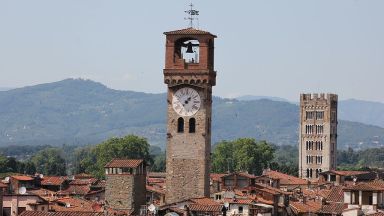
Leave the square at its south east corner along the Via Roma. Turn first left onto Via Fillungo. The Torre delle Ore is on your right.
Climbing up the Torre delle Ore offers breathtaking views of the city. This clock tower, dating back to the 13th century, chimes every 15 minutes. However, be cautious not to stand near the bell when it rings, as it can be quite loud.
As you ascend the tower, you’ll come across informative boards detailing its fascinating history, providing interesting insights and breaking up the long climb.
Impressively, the Torre delle Ore is actually the tallest tower in Lucca, standing at 50 meters, surpassing the more renowned Guinigi Tower, which is 45 meters tall. The advantage of ascending the Torre delle Ore instead of Guinigi Tower is twofold: from the top, you can enjoy a view of Guinigi Tower adorned with its iconic rooftop oak trees, and the Torre delle Ore is generally less crowded with tourists. On the other hand, if you climb Guinigi Tower, it’s challenging to see the tower itself due to the obstructing trees.
For panoramic vistas and a less crowded experience, the Torre delle Ore is a fantastic choice to admire the enchanting cityscape of Lucca from above.
Visiting Torre delle Ore: Open mid-March to early November only, from 10.30am to between 4pm and 7:30pm depending on the season. Tickets are €5, or get a combination ticket.
Location: Torre delle Ore, Via Fillungo, Lucca, Province of Lucca, Italy | Price: A combination ticket covering the nearby Torre Guinigi or the Orto Botanico costs €6/4 (or €9/6 for all three sights).
Read more about Torre delle Ore in Lucca
Domus Romana
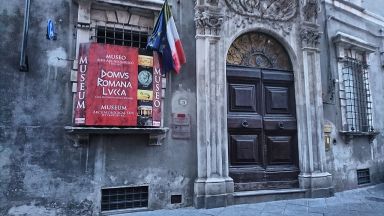
Continue walking along Via Fillungo and take the second lane on the left. At the next corner, the Domus Romana is a short distance on your right.
The Domus Romana in Lucca is a fascinating history museum where you can explore archaeological discoveries and learn about the city’s history spanning over 2000 years. Walking through the museum and its excavations gives you a unique perspective on Lucca’s past. The tour begins with an informative video, and then you’ll be guided through the museum located within the remains of a Roman house unearthed in 2010, found in the basement of a modern building. The museum houses numerous artifacts and intriguing maps, providing a rich and educational experience for visitors.
Visiting Domus Romana: Tickets are €5. Open 10am-6pm every day except Tuesdays.
Location: Domus Romana Lucca Via Cesare Battisti, 15 55100 Lucca LU Italy | Hours: Open every day 10.00 - 18.00 Closed on Tuesdays | Price: €5.00 | Website
Read more about Domus Romana in Lucca
Palazzo Pfanner-Controni
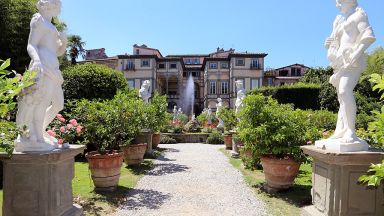
Continue along Via S. Giorgio and take the first right.
Palazzo Pfanner-Controni is a delightful 17th-century villa featuring a charming Baroque garden. The garden itself is a serene oasis, exuding the enchanting fragrance of roses and lemon blossoms. Visitors can relish in the tranquility while exploring the well-manicured pathways and lush greenery.
Moreover, a tour of a small section of the palace interior is available, allowing guests to step back in time and appreciate the grandeur of the past. This combination of a lovely Baroque garden and the glimpse into the palace’s interior creates a memorable and enriching experience for all who visit Palazzo Pfanner-Controni.
Visiting Palazzo Pfanner-Controni: Open Apr-Nov, 10am-6pm. Tickets to the gardens and residence are €4.50 each or €6.50 combined.
Location: Palazzo Pfanner, Via degli Asili, Lucca, Province of Lucca, Italy
Read more about Palazzo Pfanner
Basilica of San Frediano
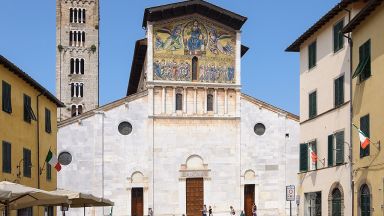
Turn left out of Palazzo Pfanner and first left onto Via Cesare Battisti. When you reach Basilica di San Frediano walk clockwise around it to reach the entrance.
The Basilica of San Frediano is a renowned Romanesque church that boasts a stunning golden mosaic on its facade, capturing the attention of visitors. Constructed during the 12th and 13th centuries, the basilica actually predates the cathedral, adding to its historical significance.
Inside, one of the most captivating attractions is the mummy of St. Zita, a young girl who passed away in 1272. Remarkably, her body naturally mummified, and upon its discovery, it was found to be miraculously preserved, showing no signs of deterioration. This extraordinary occurrence led to her being recognized as a saint, making her mummy an intriguing and sacred relic housed within the basilica. The combination of its striking exterior and unique interior makes the Basilica of San Frediano an extraordinary and spiritually significant site in Lucca.
Basilica of San Frediano Key Information: Open 9:30am-4:30pm every day. Tickets are €3.
Location: Basilica di San Frediano, Piazza San Frediano, Lucca, Province of Lucca, Italy
Read more about San Frediano Church, Lucca
Piazza dell Anfiteatro
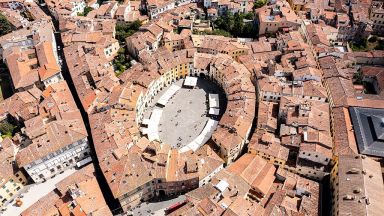
From the entrance to the Church walk straight across Piazza San Frediano and turn left into to Via Fillungo. Either turn first right and right again to reach Piazza dell’Anfiteatro; if you would like to see more of the shops, turn second right, right again along the narrow Via del Portico. You are now behind the dell’Anfiteatro, so turn right and then left to enter.
Piazza dell’Anfiteatro, also known as Anfiteatro Romano or Piazza del Mercato, holds a fascinating historical background. In the ancient times of the first to second centuries BC, a Roman amphitheatre once stood at this location. Although the original structure was destroyed and its foundations now lie several meters underground, the shape of the amphitheatre is still evident today, thanks to the houses built by the inhabitants of Lucca during the Middle Ages, which followed the old walls.
If you carefully observe the buildings lining the street that follows the outer curve of the amphitheatre, you can spot some old arches and stones that once belonged to the original amphitheatre, providing a glimpse of its past grandeur. In recent history, this square used to host a market, but nowadays, it is adorned with touristy cafes and upscale shops, creating a lively and vibrant atmosphere that attracts visitors from all over. Piazza dell’Anfiteatro is not only a historical gem but also a bustling and charming destination to explore in Lucca.
Location: Piazza dell'Anfiteatro, Piazza dell'Anfiteatro, Lucca, Province of Lucca, Italy | Hours: 24 Hours | Price: Free
Read more about Piazza dell Anfiteatro, Lucca
Guinigi Tower (Torre Guinigi)
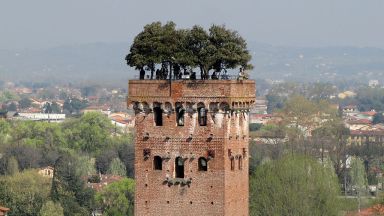
Take the southenr exit from the Piazza dell’Anfiteatro, turn left then first right down Via Canuleia. Walk straight across at the crossroads into Via delle Chiavi D’Oro, Torre Guinigi is at the end of the road.
The Guinigi Tower is a fascinating and iconic attraction, renowned for its unique rooftop garden filled with trees. Standing at a height of 45 meters, this tower dates back to the 14th century and has become a symbol of Lucca.
Commissioned by the wealthy and influential Guinigi family, the tower served as a display of their affluence and prominence in the city. The rooftop garden, adorned with oak trees, holds symbolic significance, representing the rebirth of the city.
Visitors can enjoy panoramic views from the top of the tower, amidst the lush greenery of the garden. However, it is essential to note that the tower can get quite crowded. To avoid long queues on the narrow steps, it is advisable to visit early in the day or during late hours. This way, you can fully appreciate the beauty and splendor of the Guinigi Tower without the inconvenience of overcrowding. The Guinigi Tower marks the final stop on the walking tour and offers an unforgettable experience in the heart of Lucca.
Visiting Guinigi Tower: Tickets are €5. Opens all year round from 10am. Closes between 4pm and 8:30pm depending on the season.
Location: Guinigi Tower, Via Sant'Andrea, Lucca, Province of Lucca, Italy | Hours: January 1 - March 20: 10.00 - 16.00 21 March - 31 May: 10.00 - 18.30* (* Saturday and Sunday closing 19:30) 1 June - 20 September: 10.00 - 19.30* (* June -Luglio: Saturday and Sunday closing at 8.30 pm; August: Saturday and Sunday closing at 20.00) 21 September - 30 September 10.00 - 18.30 1 October - 31 December: 10.00 - 16.00 (closed on 25 December) | Price: Adults € 6.00 | Website
Read more about Guinigi Tower
Church of St Maria della Rosa
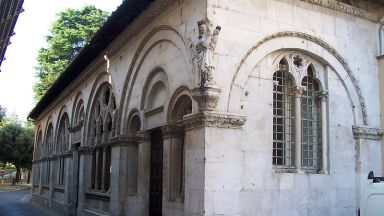
Turn left out of Guinigi Tower, past the Museo del motore a scoppio Barsanti, a small museum to tell the true story of the inventors of the internal combustion engine, Barsanti and Matteucci (https://www.barsantiematteucci.it/). Turn right at the t-junction down Via dell’Angelo Custode until you reach Chiesa di Santa Maria della Rosa.
The Church of Saint Mary della Rosa is a captivating Gothic church dating back to the 13th century, and what makes it truly remarkable is its integration with a section of the ancient Roman city wall. The church’s exterior features a stunning façade facing the street, while its interior exudes a unique and atmospheric ambiance.
Inside the church, a fascinating sight awaits visitors as they can observe the large stone blocks from the ancient Roman wall, which have been incorporated into the left side of the building. This blend of architectural styles and historical elements adds to the church’s allure and offers a glimpse into the rich layers of history that Lucca holds.
Location: Chiesa di Santa Maria della Rosa, Via della Rosa, Lucca, Province of Lucca, Italy
Read more about Church of St Maria della Rosa
You are now within sight of San Colombano Bulwark, where you can retrace your steps to the train station.
This website uses affiliate links which earn a small commission at no additional cost to you.
